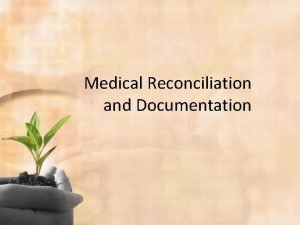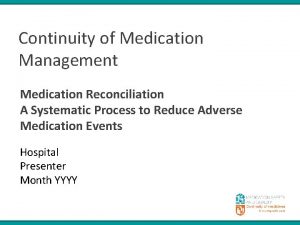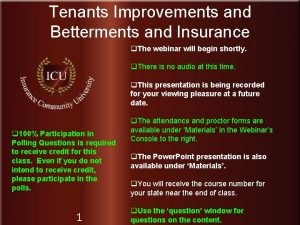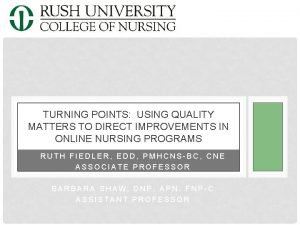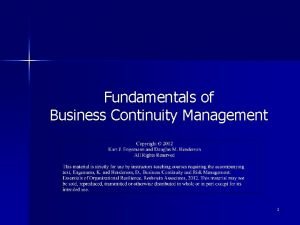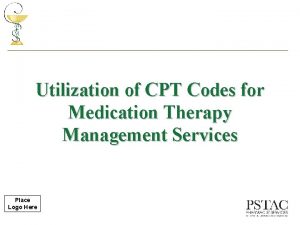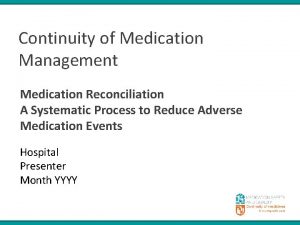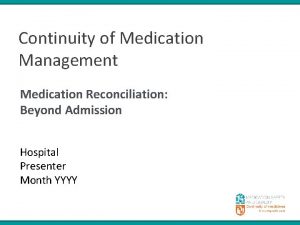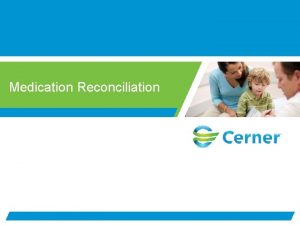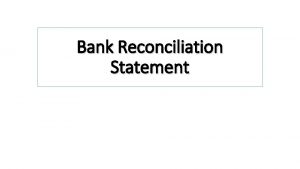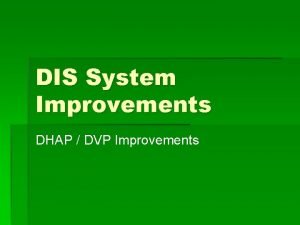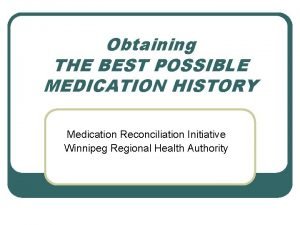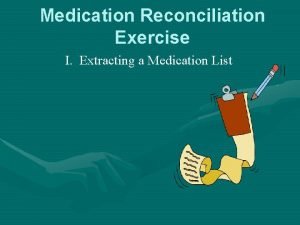Continuity of Medication Management Spreading Medication Reconciliation Improvements
















- Slides: 16

Continuity of Medication Management Spreading Medication Reconciliation Improvements Hospital Presenter Month YYYY

Continuity is an Issue in Health Care • 10 -67% of medication histories contain at least one error 1 • Incomplete medication histories at the time of admission have been cited as the cause of at least 27% of prescribing errors in hospital 2 • The most common error is the omission of a regularly used medicine 3 • Around half of the medication errors that happen in hospital occur on admission or discharge 4 • 30% of these errors have the potential to cause harm 3, 5

Local Examples - Medication Errors <Insert summarised case notes> <Insert resulting effect on patient> <Insert consequence e. g. contributed to death> <Insert resulting effect on patient> <Insert consequence e. g. caused moderate to severe harm> <Insert resulting effect on patient> <Insert consequence e. g. caused minor harm>

Quality Improvement • <Insert name of ward/unit> • <Insert names of Quality Improvement team members> • <Insert Aim Statement> Specific, Measurable, Aspirational, Realistic, Time based

Diagnosis of Problem • <Insert process undertaken e. g. - Process flow chart - Brainstorming - Ishikawa (cause and effect) diagram - Prioritising causes - Weighted voting - Pareto chart>

Problem Work Flow • <Insert copy of flow chart>

Ishikawa (Cause and Effect) Diagram Insert group name Insert cause Insert cause Insert cause Insert effect Insert cause Insert cause Insert group name

Prioritising Causes • <Insert copy of Pareto chart>

Highest Scoring Causes • <Insert a description of each of the highest scoring causes on the Pareto chart>

Agreed Strategies • <Insert agreed strategies and work plan>

Improvements • <Insert improvement results e. g. run charts>

Lessons Learned • <Insert what worked well, and what didn’t work well>

Strategies for Sustaining Improvements • <Insert strategies e. g. - Real time measuring and reporting Continual training of new staff Ingraining as standard process Documentation of procedure, protocols and guidelines - Encourage feedback - Continually review and refine using feedback>

Strategies for Spread • <Insert strategies e. g. - Form unit/ward quality improvement team - Compare existing process to trial teams experience - Are there any differences requiring consideration? - Review previous teams results - Are causes similar? - Are strategies achievable? - Trial existing or adapted strategies - Measure improvements and refine if required - Communicate to next unit/ward>

Further Information • Clinical Excellence Commission (CEC) Enhancing Project Spread and Sustainability – A Companion to the ‘Easy Guide to Clinical Practice Improvement’ • www. cec. health. nsw. gov. au/programs/clinical -practice

References 1. Tam V, Knowles SR, Cornish PL, Fine N, Marchesano R, Etchells EE. Frequency, type and clinical importance of medication history errors at admission to hospital: a systematic review. CMAJ 2005; 173: 510 -5. 2. Dobrzanski S, Hammond I, Khan G, Holdsworth H. The nature of hospital prescribing errors. Br J Clin Govern 2002; 7: 187 -93. 3. Cornish PL, Knowles SR, Marchesano R, Tam V, Shadowitz S, Juurlink DN, Etchells EE. Unintended medication discrepancies at the time of hospital admission. Arch Intern Med 2005; 165: 424 -9. 4. Sullivan C, Gleason KM, Rooney D, Groszek JM, Barnard C. Medication reconciliation in the acute care setting: opportunity and challenge for nursing. J Nurs Care Qual 2005; 20: 95 -8. 5. Vira T, Colquhoun M, Etchells EE. Reconcilable differences: correcting medication errors at hospital admission and discharge. Qual Saf Health Care 2006; 15: 122 -6.
 Absolute continuity implies uniform continuity
Absolute continuity implies uniform continuity Med reconciliation definition
Med reconciliation definition Medication management plan
Medication management plan Leapfrog medication reconciliation
Leapfrog medication reconciliation Improvements and betterments insurance
Improvements and betterments insurance Was invented by stephanie kwolek in 1966
Was invented by stephanie kwolek in 1966 Allied home improvements
Allied home improvements Offsite improvements
Offsite improvements Improvements roadmap
Improvements roadmap Direct improvements
Direct improvements Medicare improvements for patients and providers act
Medicare improvements for patients and providers act Sae reconciliation process clinical data management
Sae reconciliation process clinical data management Business continuity management wiki
Business continuity management wiki Business continuity management
Business continuity management Bussiness continuity plan
Bussiness continuity plan Mit crisis management and business continuity
Mit crisis management and business continuity Cpt code for medication management
Cpt code for medication management

